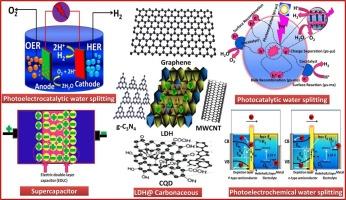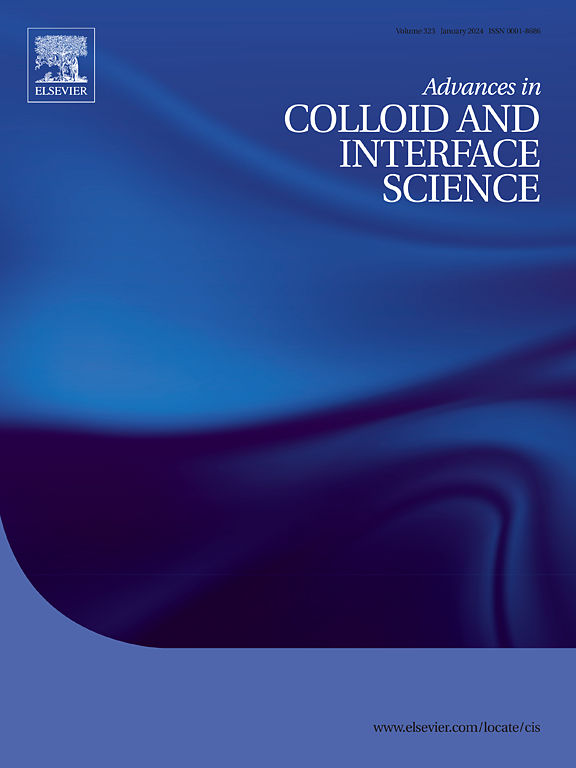ldh -碳质耦合结构在水分解和超级电容器方面的应用进展
IF 19.3
1区 化学
Q1 CHEMISTRY, PHYSICAL
引用次数: 0
摘要
利用太阳能驱动化学反应,通过太阳能燃料生产和储存能量,是建立可持续未来、解决全球化石燃料需求的最终途径。在这种情况下,设计高效、经济的催化剂,通过水分解和电化学储能来生产和储存氢气,对于实现先进的催化性能至关重要。在众多材料中,层状双氢氧化物(LDHs)由于其可调节的过渡金属阳离子、层间阴离子、缺陷形成和强大的物理化学稳定性,已成为光催化(PC)、光电化学(PEC)、电催化(EC)水分解和超级电容器(SC)应用中适应性强、高效的催化剂/助催化剂/电极材料。LDH -碳质材料(GO、g-C3N4、CNTs和CQDs)的耦合结构表现出不同寻常的性能,包括增强的表面积、亲水性和导电性,这些都有助于提高性能。本文综述了LDH -碳杂化材料在EC、PC、PEC和SC方面的最新研究进展。首先,综述了LDH和LDH -碳质杂化物的特性特征。然后,改性策略的进展详细说明了具有LDH的活性碳物质如何改变LDH -碳杂化物,从而提高实时应用的整体水分解和储存性能。综述了近年来碳质改性LDH的研究进展,并对其在能源领域的应用前景进行了展望。本文章由计算机程序翻译,如有差异,请以英文原文为准。

Advancement of LDH-carbonaceous coupled structure towards promising water splitting and supercapacitor applications
Utilizing solar energy to drive chemical reactions for producing and storing energy via solar fuel is the ultimate way to build a sustainable future that addresses global fossil fuel requirements. In this context, designing efficient and cost-effective catalysts for H2 production and storage via water splitting and electrochemical energy storage is crucial for achieving advanced catalytic performance. Among numerous materials, layered double hydroxides (LDHs) have emerged as adaptable and efficient catalysts/co-catalysts/electrode materials in photocatalytic (PC), photoelectrochemical (PEC), electrocatalytic (EC) water splitting, and supercapacitor (SC) applications owing to their tunable transition metal cations, interlayer anions, defect formations, and robust physicochemical stability. A coupled structure of LDH‑carbonaceous materials (GO, g-C3N4, CNTs, and CQDs) exhibits unusual properties, including an enhanced surface area, hydrophilicity, and conductivity, which contribute to superior performance. This review focuses on recent advancements in the fabrication process of LDH‑carbonaceous hybrid towards EC, PC, PEC, and SC applications. Firstly, the characteristic features of LDH and the LDH‑carbonaceous hybrid were summarized. Then, the progress of the modification strategy elaborates on how the active carbonaceous species with LDHs alter the LDH‑carbonaceous hybrid towards enhancing overall water-splitting and storage performance for real-time applications. Further, this review summarizes the recent advancement in LDH properties through carbonaceous modification and deliberates the prospects for future advancement of energy applications.
求助全文
通过发布文献求助,成功后即可免费获取论文全文。
去求助
来源期刊
CiteScore
28.50
自引率
2.60%
发文量
175
审稿时长
31 days
期刊介绍:
"Advances in Colloid and Interface Science" is an international journal that focuses on experimental and theoretical developments in interfacial and colloidal phenomena. The journal covers a wide range of disciplines including biology, chemistry, physics, and technology.
The journal accepts review articles on any topic within the scope of colloid and interface science. These articles should provide an in-depth analysis of the subject matter, offering a critical review of the current state of the field. The author's informed opinion on the topic should also be included. The manuscript should compare and contrast ideas found in the reviewed literature and address the limitations of these ideas.
Typically, the articles published in this journal are written by recognized experts in the field.

 求助内容:
求助内容: 应助结果提醒方式:
应助结果提醒方式:


